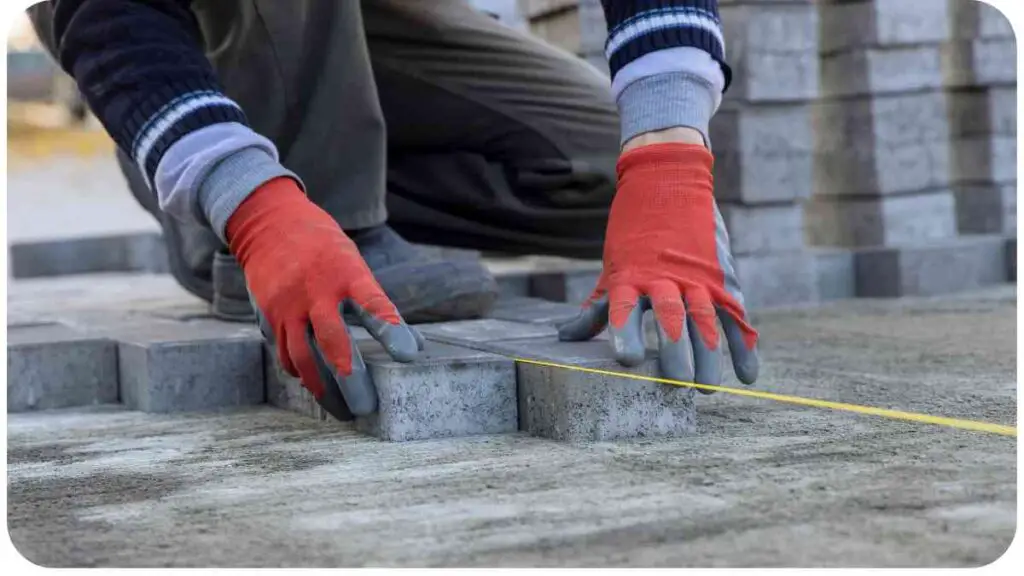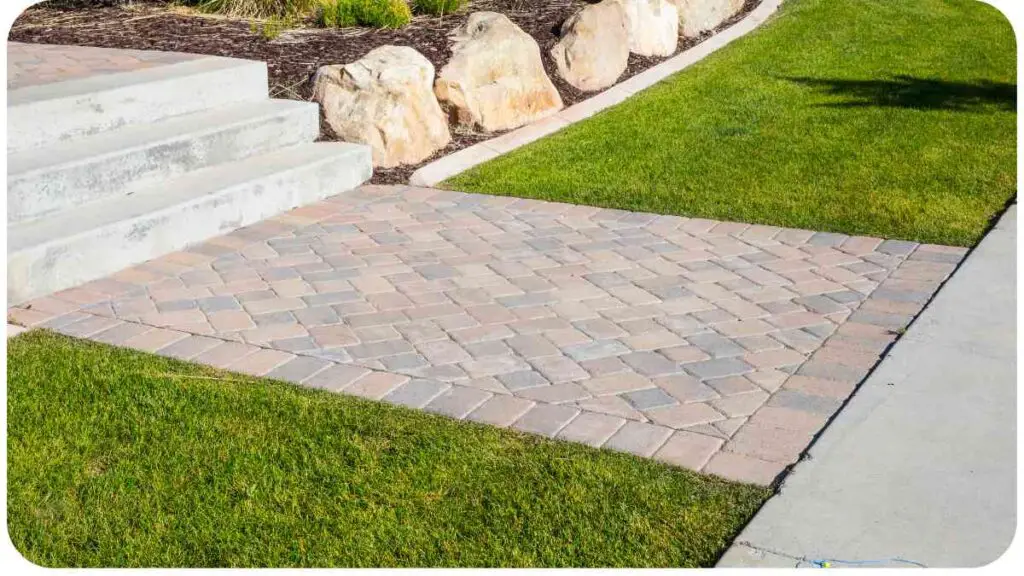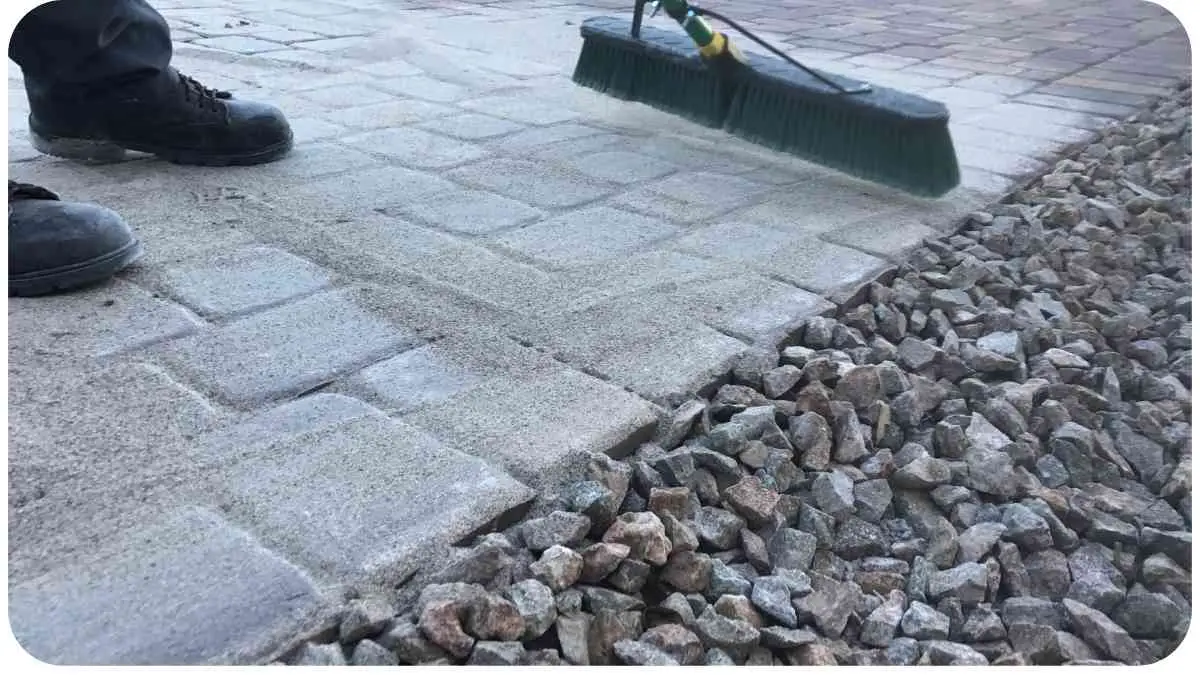Wondering if your outdoor pavers need sealing? This guide provides a detailed walkthrough to help you assess and maintain your outdoor haven effectively. Discover tell-tale signs, perform quick tests, and learn when to reseal for long-lasting beauty.
| Takeaways |
|---|
| Paver sealing can help protect your pavers from wear and tear, as well as prevent stains and color fading. |
| Not all pavers require sealing, so consider the climate and level of foot traffic in the area before deciding whether to seal your pavers. |
| The frequency of sealing your pavers will depend on the type of sealer used, the material of your pavers, and the level of foot traffic. |
| It’s possible to seal your pavers yourself, but it’s important to follow the manufacturer’s instructions carefully and use the right equipment. |
| Hiring a professional to seal your pavers can ensure a proper application and save you time and effort. |
This is one example of a tell-tale sign that you should look for if you want to know whether your pavers need sealing.
Assessing Signs of Deterioration
Initiating the process of determining whether your pavers require sealing involves a meticulous examination of surface conditions. Follow these steps to identify potential deterioration:
- Cracks: Inspect the paver surface thoroughly for the presence of cracks. Hairline fractures or more extensive cracks may indicate a need for sealing, as water infiltration can accelerate deterioration.
- Chipping: Examine the edges and corners of the pavers for any chipping. Chipped areas compromise the integrity of the surface and may necessitate sealing to prevent further damage.
- Crumbling: Check for any sections of the pavers that exhibit crumbling or disintegration. Crumbling is a clear sign of wear and tear, signaling the importance of protective measures like sealing.
- Flaking: Look out for flaking on the surface of the pavers. Flakes can be indicative of weathering and exposure, emphasizing the need for a sealing regimen to enhance durability.
- Peeling Seams: Pay close attention to seams between the pavers. If you notice any peeling or separation in these areas, it suggests a potential weakening of the bond and underscores the necessity of sealing to fortify the connections.
Revitalize with a Thorough Wash and Sealant Check
Begin by giving your pavers a meticulous wash to eliminate accumulated dirt and debris. Utilize a pressure washer for a thorough cleanse, or, if time is a constraint, opt for a garden hose paired with a scrub brush. Allow the pavers to air-dry completely before proceeding with the sealing process.
In instances where a comprehensive wash is challenging due to time constraints or other factors, consider employing a cleaning agent for effective results. Prepare a solution by mixing one part white vinegar with two parts water in a bucket. Apply this mixture to your driveway; vinegar, being an acid-based cleaner, efficiently loosens dirt without causing any damage.
Post the washing and/or cleaning process, conduct a meticulous inspection of the surface. Look for signs of cracks, holes, or imperfections, especially on older driveways that may exhibit unevenness. This step is crucial for identifying areas that might require additional attention before sealing.
“When it comes to maintaining the quality and appearance of your pavers, stripping and sealing is an essential step. Our article on how to strip and seal pavers provides a comprehensive guide to help you keep your pavers looking their best.”
Conduct the Water Test
When unsure about the sealing status of your pavers, resort to the straightforward water test. Begin by placing a single drop of water on the surface of the pavers and observe its behavior closely.
- Beaded Water: If the water forms beads and rests on the surface without being absorbed, it indicates that the pavers are adequately sealed, effectively repelling moisture.
- Immediate Absorption: Conversely, if the water is swiftly absorbed into the pavers upon contact, it suggests that the sealing might be inadequate or absent, necessitating further attention.
Performing this quick assessment enables you to gauge the effectiveness of the sealing and identify areas that may require resealing for optimal protection against moisture infiltration and deterioration.
Decoding Stains on Your Pavers

When addressing stains on your pavers, it’s crucial to discern their origin before implementing any cleaning measures. Not all stains are a result of sealant issues, and understanding the type of stain is key to appropriate treatment.
- Brown or Black Stains: Stains in these shades typically stem from dirt or natural elements present in your yard. Regular wear and environmental exposure can contribute to these stains.
- White or Yellow Stains: If the stains appear in these hues, it may indicate a potential problem with the sealant on your pavers. Some pavers incorporate white or yellow sealants, often mistaken for dirt stains by homeowners unfamiliar with the distinctions.
Cautionary Measures:
- Avoid Bleach: Refrain from using bleach on white or yellow stains, as it can harm the paver’s surface and compromise any existing sealant beneath.
- Say No to Acid-based Cleaners: Steer clear of acid-based cleaners, as they can inflict more damage than bleach alone. These cleaners have the potential to harm both the surface and any residual sealant, exacerbating the issue.
“Pressure cleaners can be a great tool for cleaning pavers, but they’re not always necessary. Our article on how to clean pavers without a pressure cleaner offers alternative methods that are just as effective.”
Interpreting Spills
Spills on your pavers serve as an easily recognizable clue regarding their sealing status. Swift action in assessing spills can provide valuable insights into the effectiveness of the sealant applied.
- Fresh Spills: If the spills are fresh, immediate attention may not be necessary. Often, these pose no imminent threat to the sealant’s integrity, and prompt cleanup can prevent potential issues.
- Aged, Dry, or Cracked Spills: On the other hand, if spills have lingered for an extended period, or if they appear dry, cracked, or flaking off, this could signify a potential sealant failure. Such indications warrant a closer inspection and, if necessary, consideration for resealing to maintain the protective barrier.
Sealer Residue on Hands or Gloves
The presence of sealer residue on your hands or gloves unveils a straightforward indicator of unsealed pavers. This tangible residue serves as an immediate cue to the absence of a protective sealant.
- Hands or Gloves: Upon touching the pavers, if you notice sealer residue on your hands or gloves, it implies that the pavers lack a sealed surface. This residue is a tangible sign that the pavers are vulnerable to wear and environmental factors.
- Visual Distinction: Another effective method is a visual comparison between sealed and unsealed pavers. Sealed pavers exhibit a more even texture, resembling concrete rather than stone. In contrast, unsealed counterparts showcase a rougher appearance that starkly differs from their sealed neighbors.
“Sealing your pavers is an important step in protecting them from wear and tear, but it’s important to apply the sealer correctly to get the best results. Learn more about the best way to apply sealer to pavers in our article on what is the best way to apply sealer to pavers.”
Surface Scratch Test
Ensuring you know whether your pavers are sealed is pivotal for effective maintenance. Employ the simple yet revealing surface scratch test using your fingernail.
- White Powder Confirmation: Gently scratch the surface of the paver with your fingernail. If a white powder appears, it’s a clear indication that the paver has been sealed. This white residue is a positive sign of an intact protective layer.
- Absence of Powder or Black Residue: Conversely, if no powder appears at all or if you observe a black residue instead of the expected white one, it suggests that your pavers are likely unsealed. This absence of a white powdery substance indicates the vulnerability of the pavers to external elements without a protective seal.
Identifying Chalky Powder
A visual check for chalky powder on your pavers serves as a reliable method for determining the condition of the sealant.
- Chalky Powder Appearance: If you observe a white, chalky powder on the surface of your pavers, it’s a clear sign that the sealant has deteriorated. This signals the need for prompt reapplication to restore the protective barrier.
- Possible Causes: The presence of chalky powder could indicate that the paver installation was not completed adequately, leading to an unsealed state. Alternatively, it may suggest that the sealant itself has degraded over time due to exposure to environmental factors.
- New Installations: In the case of new installations, the absence of chalky powder implies that no sealant was applied initially. This insight is valuable for those overseeing new projects, emphasizing the importance of incorporating sealant for enhanced durability.
“It can be difficult to tell if your pavers are sealed or not, but it’s an important thing to know in order to maintain their quality. Our article on how do I know if my pavers are sealed provides helpful tips and advice to help you determine if your pavers are sealed or not.”
Identifying Chalky Powder
A visual check for chalky powder on your pavers serves as a reliable method for determining the condition of the sealant.
- Chalky Powder Appearance: If you observe a white, chalky powder on the surface of your pavers, it’s a clear sign that the sealant has deteriorated. This signals the need for prompt reapplication to restore the protective barrier.
- Possible Causes: The presence of chalky powder could indicate that the paver installation was not completed adequately, leading to an unsealed state. Alternatively, it may suggest that the sealant itself has degraded over time due to exposure to environmental factors.
- New Installations: In the case of new installations, the absence of chalky powder implies that no sealant was applied initially. This insight is valuable for those overseeing new projects, emphasizing the importance of incorporating sealant for enhanced durability.
Joints Integrity Test

Determining the sealing status of your pavers involves a practical examination of the joints, employing a simple yet revealing test.
- Screwdriver Examination: Utilize a screwdriver to gently pry up one of the joints between the pavers.
- Loose Joints Indicate Sealing: If the joint proves to be loose, it serves as an indicator that the pavers have been effectively sealed. This loose joint suggests that the sealant has allowed for flexibility, accommodating environmental stresses without compromising the integrity of the paver system.
- Intact Joints Offer Assurance: Conversely, if the joints resist prying and remain secure, it implies that the pavers are likely safe and adequately sealed. The stability of the joints indicates a robust sealing application, ensuring the cohesion of the paver installation.
“Building a paver patio can be a great addition to your outdoor living space, but it’s important to consider the cost before beginning the project. Our article on how much does a 20×10 paver patio cost offers a breakdown of the expenses you can expect when building a paver patio.”
Polish Test
Verify the efficacy of your paver sealing through a practical and revealing polish test. This tactile examination provides insights into the current state of the sealant.
- Rubbing with a Dry Towel: Select a small section of your pavers and rub it gently with a dry towel.
- Shiny and Smooth Surface: If the surface exhibits a shiny and smooth appearance after rubbing, it signifies that the sealer is still intact. This sheen and smoothness are positive indicators of an effective protective layer.
- No Change or Rough Feel: On the contrary, if there’s no noticeable change in appearance or if the surface feels rough after rubbing, it suggests that the particular area of your patio may no longer be adequately sealed. This can prompt further inspection and, if necessary, considerations for resealing to maintain optimal protection.
Conclusion
Investing in a quality sealer acts as a shield, ensuring the prolonged beauty and resilience of your pavers against the elements. A well-maintained seal provides peace of mind, allowing you to relish your outdoor space for years without fretting over weather-induced wear.
Don’t Let Uncertainty Linger! Should you sense the need for resealing your pavers but harbor doubts about their current status, the tests outlined here serve as practical tools for clarification. Empower yourself with the knowledge gained from these assessments to gauge the longevity of your pavers and take timely action to safeguard their longevity and aesthetic allure.
With a vigilant eye and proactive measures, your outdoor oasis can stand resilient against the test of time, weathering each season with enduring charm.
Further Reading
Paver Sealing Frequently Asked Questions: This article provides answers to frequently asked questions about paver sealing, including how often to seal pavers and the benefits of sealing.
Do Pavers Need to Be Sealed?: This article discusses the pros and cons of sealing pavers and provides tips for maintaining unsealed pavers.
Paver Sealant: Seal or Not to Seal: This article discusses the benefits of sealing pavers, the types of sealers available, and provides tips for applying sealer.
FAQs
Should I seal my pavers?
Sealing your pavers can help protect them from wear and tear, as well as prevent stains and color fading. However, it’s not always necessary to seal your pavers, especially if they’re made from a durable material like concrete. Consider the climate and level of foot traffic in the area before deciding whether to seal your pavers or not.
How often should I seal my pavers?
The frequency of sealing your pavers will depend on the type of sealer used, the material of your pavers, and the level of foot traffic. As a general rule, it’s recommended to seal your pavers every 2-3 years. However, some sealers may require more frequent application.
Can I seal my pavers myself?
Yes, it is possible to seal your pavers yourself. However, it’s important to follow the manufacturer’s instructions carefully and use the right equipment to ensure a proper application. Alternatively, you can hire a professional to seal your pavers for you.
How long does it take for paver sealer to dry?
The drying time of paver sealer will depend on the type of sealer used and the weather conditions. In general, most sealers will dry within 24 hours. However, it’s important to avoid walking or driving on the pavers until the sealer is completely dry.
Can I apply sealer to wet pavers?
No, it’s important to wait until the pavers are completely dry before applying sealer. Applying sealer to wet pavers can result in an uneven application and may cause the sealer to peel or flake off over time.

I am Hellen James, a landscape architect. For many years I have written about landscaping for various publications; however, recently decided to focus my writing on personal experience as a profession.

